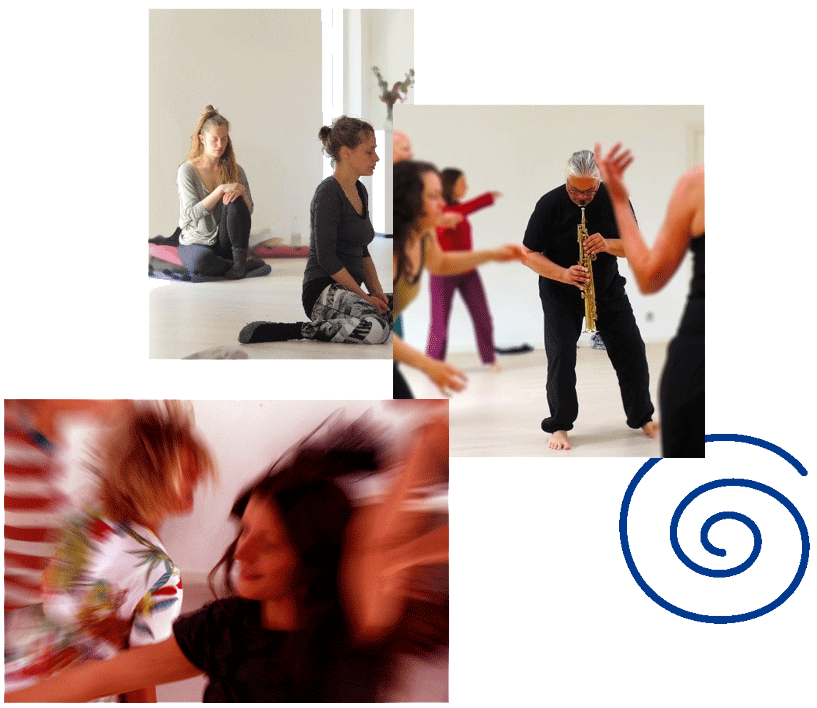Moving Meditation is an organic family of individual and collective meditative
practices with a special approach through the wakeful body. We work in the entire spectrum from
deep silence to intensive movement. It is an non-dogmatic, open, explorative form, and will have a
familiar feel to it if you already have some kind of meditation practice with roots in mindfulness,
vipassana, Buddhist meditation, TM and many other things in the family of deep awareness
training. The special characteristic of MM is a systematic involvement of the body, not just as
source of experiences but as living, participatory reality.
The methods are introduced step by step, with feedback and reflection, so that they are always directly applicable and alive for the experienced and for newcomers alike. Some of the methods are individual exercises, others are practices for groups of various sizes. Some explore a general opening into moving awareness, others go in through specific approaches such as “moving and being moved”, “self-consciousness” or “habits in the body”. We are currently finishing a book describing 50 Moving Meditation practices. Four of them are already available as CD’s / sound files with guided meditations (see the page PUBLICATIONS).

MM’s style of practice is also characterized by lightness and humorous depth. Sometimes you may
encounter strong waves of sorrow, joy or other moods in moving meditation, but this is all
transient. What you train and expand is your wakeful ability to be open and flowing with it. To be
“dancing with what is”. Not a particular kind of experience or being.
Philosophical process is integral to Moving Meditation. Not as academic lectures and fixed frameworks, but as living and shared listening and reflection in fresh experience. It is true of all kinds of meditation that this helps cultivate a layer of meditative insight and stabilization of benefits. But it is particularly vital in Moving Meditation bevause we tend to have particularly narrow understandings of the ways our bodies shape our lives – or indeed ARE our lives.
Our sources and inspirations in developing Moving Meditation have been many. It is as if a cluster of practices and insights in the spirit of our time came together on their own initiative and invited us to play along. Particularly important inspirations are Buddhist wisdom traditions (particularly dzogchen, via Chögyam Trungpa and Tulku Urgyen Rinpoche’s heirs), the Osho tradition (via Michael Barnett), the recent wave of mindfulness meditation (Jon Kabat-Zinn and others) and a ramified contemporary of culture in body and movement (Feldenkrais, Five Rhythms, Authentic Movement and many other expressions). We very clearly cannot be said to have invented anything that was not already happening, it is more that we go along with somthing that the spirit of the time is cooking. Perhaps one can say that we do this thoroughly with 100% embodiment and 100% meditation where many of the great sources of inspiration tend to be 100% in one of the sides with some more partial openings to the other side.
We are also deeply inspired by several philosophical openings into process thought, systems thought and philosophy of organism, evolution, relationality and aesthetics (Goethe, Whitehead, Bergson, Bateson, Varela) – but again, this is as modes of practical work and explorative dialogue rather than fixed systems of thought.
Finally we would like to mention that the work of Moving Meditation is very much nourished by a third stream of culture beside the two obvious ones, East and West. The embodied energy of groovy rhythms is essential to much of the practice of Moving Meditation. So rather than the classical idea of East-meets-West we ought perhaps, just because the living moving body is so very essential, we should perhaps speak of the meeting of three currents, East, West and South.
You can follow some of our ongoing exploration of methods, materials, sources, training forms etc in our blog www.wisdom-in-process.com
